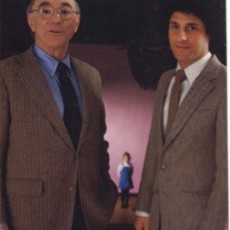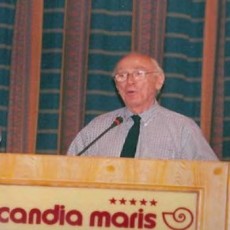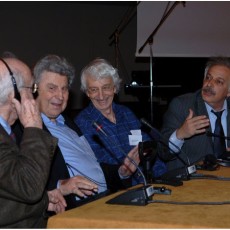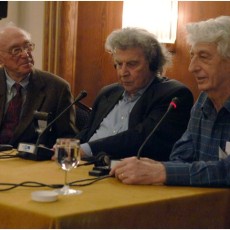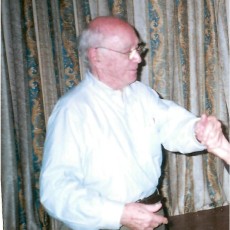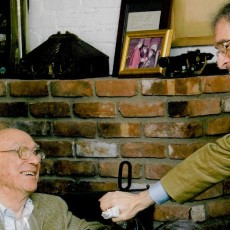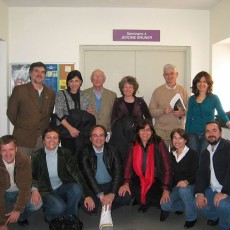Jerome “Jerry” Bruner

Jerome “Jerry” Bruner is Research Professor of Psychology and Senior Research Fellow in Law at New York University. As a co-founder and past director of the Harvard University Center for Cognitive Studies, Bruner’s pioneering research on perception and cognitive processes laid the foundation for social science scholarship for more than a half-century. Having served as a member of the President’s Science Advisory Committee in the Kennedy and Johnson Administrations, Bruner was an influential architect in the development of new social studies curriculum for the middle grades and the early childhood program Head Start. A past president of the American Educational Research Association and the recipient of numerous awards and honorary degrees, Bruner authored several bestselling books including his early works The Study of Thinking (1956) and The Process of Education(1960) which has been translated into nineteen languages and has sold more than 500,000 copies. Later advocating for the development of a cultural psychology, Bruner also examined the importance of storytelling as a process of construction in education and law. Bruner remains an active adjunct professor at New York University School of Law, continuing to explore the interaction of culture and legal practice while studying the role of storytelling in the legal process.
To learn more about Jerry Bruner from his family and friends, visit his Reflections. To view photographs from Jerry Bruner’s personal collection, visit his Photo Gallery.
Suggested readingsVisit the video below to watch a short overview of the interview with Jerry Bruner. Otherwise, see all four of the full interviews with Jerry Bruner below.
Video Interviews with Jerome “Jerry” Bruner:
Fondly recalling the close-knit neighborhood of his youth, Dr. Jerome “Jerry” Bruner remembers fun-filled days spent playing with “the gang” of other young boys on Seneca Street in New York City. Bruner, the son of Polish immigrants, attended public schools with his two siblings on the outskirts of the city and later graduated from Duke University. Both a talented athlete and inquisitive scholar, Bruner expressed an early interest in research, initially examining the behavior of lab rats. Watch this clip to learn more about Dr. Bruner’s unparalleled contributions to the field of education over the last six decades.
Co-founder and director of the Harvard University Center for Cognitive Studies, Dr. Jerome “Jerry” Bruner and his colleagues encouraged discourse between educational researchers and scholars who held seemingly incompatible views on learning and development. Through his research at the center, Bruner inspired a cognitive revolution in psychology, influencing the work of other scholars and students around the world. Always fascinated by the idea of sea travel as a young boy, Bruner was the first (and only) professor to sail his own boat across the Atlantic Ocean to accept an academic position at Oxford University. Watch this clip to enjoy stories from Dr. Bruner about his travels and share his desire to “develop a sense of the possible.”
Often seen by his students riding a bicycle around the university campus, Dr. Jerome “Jerry” Bruner spent many of his rides “thinking of his next big idea.” Praised by his former students and colleagues for his selfless service as a scholar and mentor, Bruner appreciates his students as individuals. Also a competitive croquet player, Bruner insists that he can “beat the stuffin’ out of anyone” who plays the game. Acquainted with all the leading scholars of the current and last century, Bruner describes those teachers and colleagues who have influenced him the most. When watching this clip, also be prepared to share Dr. Bruner’s enthusiasm for the latest ideas in educational research.
The recipient of numerous awards and honorary degrees, Dr. Jerome “Jerry” Bruner values the praise of his students and colleagues who describe him as a visionary in the field of educational psychology and beyond. Adamant in his belief that “behavior cannot be chopped out of context,” Bruner insists that “the world that you see is what you expect to see.” Inspired by the art of conversation, he can still recite pages of his favorite poetry from memory. Watch this clip to hear Dr. Bruner’s advice for graduate students and his dreams for the future.
Amrein-Beardsley, A. (2011, December 1). Inside the Academy video interviews with Dr. Jerome Bruner [Video files]. Retrieved from /inside-the-academy/jerome-jerry-bruner
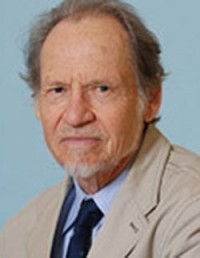
Dr. Oscar Chase
Describing his friend and colleague Dr. Jerome “Jerry” Bruner as “intellectually curious and adventurous, scholarly, and a deeply caring teacher,” Dr. Oscar Chase notes also that he is “a warm and loving friend.” Having worked together at the New York University School of Law for more than a decade, Oscar and Jerry have often co-taught a seminar called “Culture and Law.” Citing his friend’s distinguished contributions to the field of cognitive psychology, Oscar explains that Jerry “brought human agency back to the forefront of the field.” Also serving as a consultant to early child educators in Italy, Jerry remains dedicated to the education of young children. Praising his friend for the “care and time [that] he put into working with students on their own research,” Oscar describes Jerry as a “generous and thoughtful mentor” who shaped his own development as a scholar. Illustrating his friend’s profound influence as an authority in the field, Oscar notes that Jerry also testified as an expert witness on behalf of the plaintiffs during litigation in Brown v. Board of Education. Although Jerry’s acquaintances include “just about every important intellectual figure of the current and last centuries,” his legacy remains his selfless dedication to his students in the eyes of Oscar and generations of other young scholars.

Dr. Michael Cole
Having first met while working on an education project in Liberia, Dr. Jerome “Jerry” Bruner and Dr. Michael Cole have shared an interest in the role of culture in human development for the past five decades. Working alongside Jerry as a beginning researcher, Mike and other colleagues from Yale University evaluated the Man: A Course Study project during its transition from Newton, Massachusetts to a small town in Connecticut. As co-authors of an article on cultural differences and deficits, Mike and Jerry continued to collaborate throughout the early 1970s. Both great admirers of the Russian psychologist Alexander Luria with whom Jerry exchanged frequent correspondence, Mike has long enjoyed working together, especially on issues of common interest. Describing his friend and colleague as “a major figure [who has] helped psychology to reconnect with its roots in the human sciences,” Mike notes that Jerry’s revolutionary work on “life as narrative” and the “narrative sources of the self” have been particularly influential in his own thinking as a scholar.
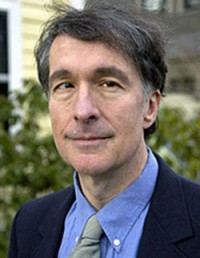
Dr. Howard Gardner
Dr. Jerome “Jerry” Bruner “is not merely one of the foremost educational thinkers of the era [but] also an inspired learner and teacher” to his friend and colleague Dr. Howard Gardner. Hired to work as a research assistant on the middle school curriculum project Man: A Course of Study, Howard reflects on the life-changing experience, noting that his long-time friend has been a “major role model in many spheres of [his] life.” Admired by Howard as a “prolific and versatile scholar,” Jerry has “approached education as a broad thinker rather than as a technician…enlarging our sense of how children learn.” Howard also describes Jerry as “extremely youthful [and] athletic with the features of a much younger person,” maintaining that he appears much younger than his age to many colleagues and friends. At the age of 96, Jerry remains the “youngest and most eager child in the class.” Likening Jerry to “Moses” in many fields of study, Howard insists that he “sees the field first, makes the initial profound statement of problems and methods, gives the work a good start in the right direction, and moves on to the next fertile area.” Praising Jerry for his unparalleled contributions to the field, Howard captures the nature and essence of his friend simply and concisely, explaining that “Jerome Bruner has no peers.”
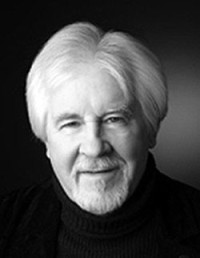
Dr. James Gavelek
Characterizing Dr. Jerome “Jerry” Bruner as a mentor to “a laundry list of major figures in psychology and the other social sciences,” Dr. James Gavelek “count[s] him as one of the most influential individuals on [his] own thinking.” Through his pioneering research at the Harvard University Center for Cognitive Studies, Jerry spurred the cognitive revolution in the field of psychology. Noting Jerry’s instrumental role in the introduction of Russian psychologist Lev Vygotsky to American scholars, James also highlights his development of the learning sciences and spiral curriculum. James describes his friend’s leadership role in the Woods Hole Conference (1959), held in response to the Russian launch of the satellite Sputnik. Jerry wrote his bestseller The Process of Education based on the conference objectives-the ground-breaking book has been translated into nineteen languages and sold more than 500,000 copies. Praising Jerry for his “important contributions to our understanding of concept development,” James describes the last influence of an intellectual who has shaped scholarly discourse for more than seven decades.

Dr. Alison Gopnik
As her graduate mentor and thesis advisor, Dr. Jerome “Jerry” Bruner has long been “a source of inspiration and friendship” for Dr. Alison Gopnik. Fondly recalling afternoons spent playing croquet in Jerry’s garden by the river at Oxford University, Alison describes her mentor as a model for how to live “a broad intellectual life.” Praising him for “his distinctive contribution [as a mentor to] several generations of students who have since made substantial and entirely original contributions to psychology,” Alison insists that “Jerry never had disciples-he made his students into remarkably original researchers.” Alison also remembers visiting Jerry in New York when he was already more than 80 years old, noting that he “explained in great detail an entirely new line of research looking into legal cognitive science…[at] a time when most faculty are resting on their laurels.” Explaining that “most of us would be glad to have one new idea in our careers that is interesting and innovative,” Alison describes Jerry as “the ideal mother-nurturing and scaffolding his students and the field and yet allowing both the students and science to progress in all sorts of new and unexpected ways.”

Dr. Giannis Kugiumutzakis
An admirer of Dr. Jerome “Jerry” Bruner for “his innovative research and thought-provoking theoretical works,” Dr. Giannis Kugiumutzakis became personally acquainted with Jerry during his visits to the University of Crete. Enjoying dinner at a unique, traditional café located in South Crete, Giannis admonished his friend Jerry for drinking Cretan “raki” and stealing his cigarettes, maintaining that both were bad habits for a man in his late eighties. Responding with a laugh, Jerry insisted that he felt as though he were only twenty! Giannis explains that “among his other rare qualities, Jerry is very rich because of his many friends, creative students, and his own generosity, sense of humor, and modesty.” Even at 96 years of age, Jerry “loves, works, acts, interacts, teaches, writes, makes plans, and dreams-a continuation of the person he always tried to be.” Although Jerry once described Freud, Piaget, and Vygotsky as the “three modern titans of developmental theory,” Giannis insists that his friend should be added to the list. As an “explosive, daring, and fresh” intellectual, Jerry “tried and tested scientific ideas and synthetic theories in simple, ingenious research designs, the result of which promoted our understanding on the constant interaction between human culture and nature.” Giannis characterizes the life of his friend as “full of co-created meaning…in the cultural setting in which he lives, transforms through his work, and creates for all of us.”
Recalling his friend’s tribute to Mikis Theodorakis as the key-note speaker at an international, interdisciplinary symposium in honor of the famous Greek songwriter and composer, Giannis shares the song O Antonis based on the poetry of Iacovos Kambanellis about his experiences at Mauthausen Concentration Camp.

Dr. Willem Levelt
Dr. Willem Levelt first met Dr. Jerome “Jerry” Bruner while working as a fellow at the Harvard University Center for Cognitive Studies. Fondly recalling his kindness, Willem notes that the then co-director of the center “came to play a quite important role in [his] life.” When asked to help establish a Max Planck Institute for Psycholinguistics, Willem convinced his friend Jerry to serve as the chair of the Scientific Council (the “Fachbeirat”). Jerry “played an essential role [in this position]” not only in the decision-making process required to formally establish that institute but also in selecting the location in Nijmegen, Netherlands. As a testament to the monumentous task facing the researchers, scholars, and student fellows of the new institute, Jerry presented them with a symbolic gift: a seventeenth century print of a map of the heavens to wish them good luck in mapping the world of language. Admired by his friend Willem for his distinguished contributions as a researcher and scholar, Jerry once aptly described the study of language as a “study [of] the world, and, indeed all possible worlds.”
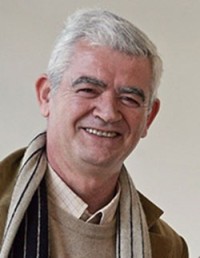
Dr. Jose Linaza
Giving credit to his Ph.D. supervisor and long-time friend Dr. Jerome “Jerry” Bruner for “rescuing [him] from animal learning [and exposing him] to a wider perspective of development,” Dr. Jose Linaza examined the experiences of rats in what Jerry dubbed “Luna Park” in reference to the rides often found at amusement parks. While provided with “curious and critical students” during his years at Oxford, Jerry often encountered criticism from colleagues in experimental psychology. Noting that Jerry’s “accomplishments in Developmental Psychology were outstanding, changing the field [with regards to] perception, thinking, early skills, play, and language acquisition,” Jose adds that his mentor has “changed our view of Mind and its relation to culture, not just in psychology, but in education, anthropology, and law.” Recalling Jerry’s recent inaugural lecture delivered at the International Congress of Psychology in Rosario, Argentina, Jose could not hide his surprise when he discovered that Jerry had “changed currency, taken a taxi, and arrived at the right place in a town he had never visited before where few people speak English.” Already 95 years old at the time, Jerry arrived at the Congress wearing the smile of “a naughty boy who had just finished an adventure.” Characterizing his friend Jerry as “permanently curious” with a mind that never stops, Jose credits his “strong and fit body” with supporting such active thinking. Jose appreciates the ageless and brilliant intellectual for the “warm and sympathetic heart that makes him a wonderful human being.”
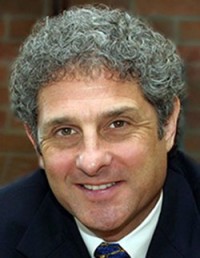
Dr. Andrew N. Meltzoff
Attending Oxford in hopes of working with Dr. Jerome “Jerry” Bruner, Dr. Andrew N. Meltzoff remembers the graduate courses taught by his mentor as magical, igniting his interest in developmental science. Eager to join the first “Bruner class” of students, Andrew fondly remembers Jerry “riding his bicycle abound the streets of Oxford” and notes that he was “hardly a world-class bicyclist.” Challenged by poor vision and the steady stream of cars driving “on the wrong side of the road,” Andrew suggests that “Jerry was probably dreaming about a big idea while riding.” According to Andrew, “Jerry was the envy of all the young male psychologists in the 1970s…always moving around a conference [with] beautiful [and] intellectually interesting women in tow.” Always able to “chat up a storm,” Jerry was “endlessly interesting”-he is a “big picture person [who] can see the future and help create it.” Andrew insists that Jerry can “see around corners and predict the future of a field before anyone else,” likening his mentor and friend to the Steve Jobs or Bill Gates of academia. With an insatiable intellectual appetite, Jerry is also “gifted at assembling one-of-a-kind teams to crack intellectual puzzles.” Praising him as “curious, creative, interested and interesting, and a mentor with match,” Andrew describes Jerry as “one who relishes the life of the mind and the hand”-he is a thinker as well as a doer. As “someone who found wisdom far before old age and held onto youthful enthusiasm long after he was young,” Jerry “would be at home in the fresco by Renaissance artist Raphael, The School of Athens-he would relish the conversation.” In the eyes of his early student, Jerry “is one of the greatest thinkers about human nature and culture to have graced intellectual history.”

Dr. Andrea Smorti
Reminiscing about their visit to a beach site near Florence, Italy, Dr. Andrea Smorti and his family enjoyed spending time with his dear friend, colleague, and mentor Dr. Jerome ” Jerry” Bruner. Eager to buy a house in Fiascherino after looking at an aerial photograph of the small village, Jerry and his then wife toured the village with disappointment-“everything seemed so different and unpleasant, being full of cars and mess.” Still mentioned in conversation, Andrea and Jerry refer to the village of Fiascherino an example of “deceptive reality,” changing considerably when passing from the big picture to a closer view. Describing Jerry from a professional and scientific point of view, Andrea notes that he is “capable of demonstrating that perception, thinking, memory, and language are acts of meaning by which the Self constructs the world” while also showing that “the Self is not only in the cranium but also in the world…as a social invention.” From a personal and human point of view, Andrew praises him for his ability to “maintain a certain ‘boyish’ attitude together along with that of a distinguished Harvard professor.” Always “able to find something interesting, unexpected, or worth of discussion in what you are saying,” Jerry turns “his whole body, rather than just his head to face you, making this attitude more apparent.” Jerry is able to “find [not only] the exceptional in the normality, but also [has] a capacity to transmit interest to his interlocutor.” According to Andrea, this is “the essence of a creative intelligence.”
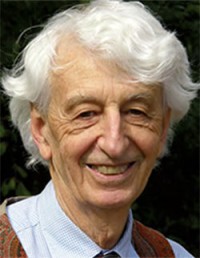
Dr. Colwyn Trevarthen
Having first met Dr. Jerome “Jerry” Bruner while working as a post-doctoral neuroscientist at the Institut de Neurophysiologie et Psychophysiologie (C.N.R.S.) in Marseille, France, Dr. Colwyn Trevarthen and his wife Lee have enjoyed “a warm friendship” with Jerry. Attempting at first to converse in French, the long-time friends eventually resolved to speak English, joking that they could not understand each other. While they often agreed on matters in psychology and life, Colwyn and Jerry also relished their many disputes. They found “searching for the issues on which there might be some disagreement” to be great fun. As a biologist, Colwyn often focused “on the gifts of human nature,” eager to challenge Jerry’s belief in the importance of “the ‘meaning’ shared in [the] creative stories of a culture.” Soon after their initial meeting, Jerry encouraged Colwyn “to make a change” with an invitation to work at Harvard. Jerry quickly recognized “Colwyn’s potential to make far greater contributions to knowledge in the field of child development”-this proved to be life-changing for both him and his family. Often collaborating in their research, Colwyn recalls a particular conversation during which Jerry jokingly asked about the fish tank in his office. Advised by Jerry to abandon his study of fish and instead examine the sociability of babies, Colwyn became “totally absorbed” in the ways that “babies communicate with their clever and affectionate mothers”-although he admittedly lost interest when the child[ren] began to talk! Colwyn describes “the scope of Jerry’s psychology [as] vast, but [notes that] the principles are simple and clear, because he loves life and people, and he loves teaching.” Characterizing his friend as “generous, humorous, outrageously original and resistant to brittle dogma,” Colwyn explains that Jerry is “committed to support[ing] creativity, its emotional value, and its sharing in cooperative story-making.” Colwyn summarizes the essence and nature of his friend, adding simply “that’s why his students love him.”


